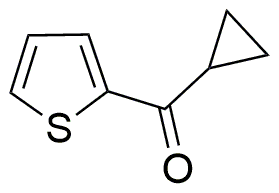Cyclopropyl 2-thienyl ketone is widely utilized in research focused on:
- Pharmaceutical Development: This compound serves as a key intermediate in the synthesis of various pharmaceuticals, particularly in the development of novel anti-inflammatory and analgesic agents.
- Agricultural Chemistry: It is used in the formulation of agrochemicals, enhancing the efficacy of pesticides and herbicides, which helps in improving crop yield and protection.
- Material Science: Cyclopropyl 2-thienyl ketone is incorporated into polymer formulations to improve thermal stability and mechanical properties, making it valuable in the production of durable materials.
- Organic Synthesis: This chemical is a versatile building block in organic synthesis, allowing researchers to create complex molecules efficiently, which is crucial for advancing chemical research.
- Flavor and Fragrance Industry: It is also explored for its potential applications in the flavor and fragrance sector, contributing to the development of unique scents and flavors.
General Information
Properties
Safety and Regulations
Applications
Cyclopropyl 2-thienyl ketone is widely utilized in research focused on:
- Pharmaceutical Development: This compound serves as a key intermediate in the synthesis of various pharmaceuticals, particularly in the development of novel anti-inflammatory and analgesic agents.
- Agricultural Chemistry: It is used in the formulation of agrochemicals, enhancing the efficacy of pesticides and herbicides, which helps in improving crop yield and protection.
- Material Science: Cyclopropyl 2-thienyl ketone is incorporated into polymer formulations to improve thermal stability and mechanical properties, making it valuable in the production of durable materials.
- Organic Synthesis: This chemical is a versatile building block in organic synthesis, allowing researchers to create complex molecules efficiently, which is crucial for advancing chemical research.
- Flavor and Fragrance Industry: It is also explored for its potential applications in the flavor and fragrance sector, contributing to the development of unique scents and flavors.
Documents
Safety Data Sheets (SDS)
The SDS provides comprehensive safety information on handling, storage, and disposal of the product.
Product Specification (PS)
The PS provides a comprehensive breakdown of the product’s properties, including chemical composition, physical state, purity, and storage requirements. It also details acceptable quality ranges and the product's intended applications.
Certificates of Analysis (COA)
Search for Certificates of Analysis (COA) by entering the products Lot Number. Lot and Batch Numbers can be found on a product’s label following the words ‘Lot’ or ‘Batch’.
*Catalog Number
*Lot Number
Certificates Of Origin (COO)
This COO confirms the country where the product was manufactured, and also details the materials and components used in it and whether it is derived from natural, synthetic, or other specific sources. This certificate may be required for customs, trade, and regulatory compliance.
*Catalog Number
*Lot Number
Safety Data Sheets (SDS)
The SDS provides comprehensive safety information on handling, storage, and disposal of the product.
DownloadProduct Specification (PS)
The PS provides a comprehensive breakdown of the product’s properties, including chemical composition, physical state, purity, and storage requirements. It also details acceptable quality ranges and the product's intended applications.
DownloadCertificates of Analysis (COA)
Search for Certificates of Analysis (COA) by entering the products Lot Number. Lot and Batch Numbers can be found on a product’s label following the words ‘Lot’ or ‘Batch’.
*Catalog Number
*Lot Number
Certificates Of Origin (COO)
This COO confirms the country where the product was manufactured, and also details the materials and components used in it and whether it is derived from natural, synthetic, or other specific sources. This certificate may be required for customs, trade, and regulatory compliance.


